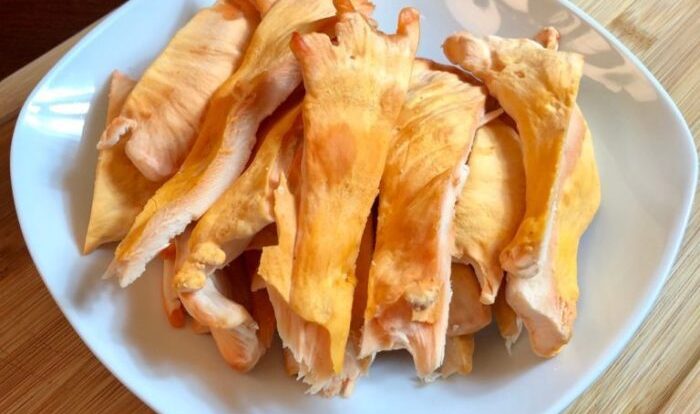
Chicken of the Woods Recipe: Embark on a culinary adventure as we explore the versatility, health benefits, and creative presentations of this unique edible mushroom. Prepare to tantalize your taste buds and learn the secrets of foraging and preparing this delectable delicacy.
Discover the distinct flavor profile and texture of chicken of the woods, and how it harmonizes with diverse cuisines and cooking techniques. Let’s dive into a step-by-step guide to create a mouthwatering dish, and uncover the nutritional value and health-promoting properties that make this mushroom a culinary gem.
Culinary Exploration of Chicken of the Woods

Chicken of the woods, a delectable edible fungus, offers a versatile culinary experience. Its unique flavor profile and texture make it a versatile ingredient, compatible with a wide range of cuisines and cooking techniques.
Flavor Profile
Chicken of the woods boasts a distinctive flavor that resembles chicken, with a hint of seafood. It possesses a mild umami taste with earthy undertones, making it an excellent substitute for meat in various dishes.
Texture, Chicken of the woods recipe
The texture of chicken of the woods varies depending on its age and cooking method. Young specimens have a tender and juicy texture, while mature ones are more firm and chewy. When cooked, it develops a meaty texture that can be shredded or sliced, making it suitable for various culinary applications.
Culinary Versatility
Chicken of the woods is a culinary chameleon, adapting effortlessly to different cuisines and cooking techniques. It can be sautéed, roasted, grilled, or fried, each method imparting a unique flavor and texture. Its versatility allows it to be incorporated into a diverse range of dishes, from soups and stews to stir-fries and pasta sauces.
Recipe Development

Chicken of the woods is a versatile mushroom that can be used in a variety of dishes. It has a meaty texture and a slightly nutty flavor. Here is a step-by-step guide to preparing chicken of the woods.
Ingredients:
- 1 pound chicken of the woods mushrooms, cleaned and cut into bite-sized pieces
- 1 tablespoon olive oil
- 1/2 teaspoon salt
- 1/4 teaspoon black pepper
- 1/4 cup chopped onion
- 1/4 cup chopped green bell pepper
- 1/4 cup chopped red bell pepper
- 1/4 cup chopped celery
- 1/4 cup chopped carrots
- 1 (15 ounce) can black beans, rinsed and drained
- 1 (15 ounce) can corn, drained
- 1 (10 ounce) can diced tomatoes with green chilies, undrained
- 1/2 cup chopped cilantro
- 1/4 cup chopped fresh lime juice
Instructions:
- Heat the olive oil in a large skillet over medium heat. Add the chicken of the woods mushrooms, salt, and pepper. Cook for 5-7 minutes, or until the mushrooms are browned.
- Add the onion, green bell pepper, red bell pepper, celery, and carrots to the skillet. Cook for 5-7 minutes, or until the vegetables are softened.
- Add the black beans, corn, tomatoes, cilantro, and lime juice to the skillet. Stir to combine.
- Bring to a boil, then reduce heat and simmer for 15 minutes, or until the sauce has thickened.
- Serve over rice or your favorite pasta.
Nutritional Analysis and Health Benefits

Chicken of the woods, a polypore fungus, boasts an impressive nutritional profile. It is low in calories and fat while being rich in fiber, vitamins, and minerals.
Nutritional Composition
Per 100 grams, chicken of the woods contains:
- Calories: 121
- Fat: 0.3 grams
- Fiber: 6.5 grams
- Protein: 10.3 grams
- Vitamin D: 100% of the Daily Value (DV)
- Potassium: 10% of the DV
- Riboflavin: 10% of the DV
- Niacin: 10% of the DV
Health Benefits
Chicken of the woods has been associated with various health benefits, including:
Immune Support
Chicken of the woods contains beta-glucans, polysaccharides that have been shown to enhance immune function. Studies have found that beta-glucans can stimulate the production of white blood cells, which play a crucial role in fighting infections.
Antioxidant Activity
Chicken of the woods is rich in antioxidants, which help protect the body against damage caused by free radicals. These antioxidants include ergothioneine, a unique amino acid that has been shown to have strong antioxidant properties.
Anti-Inflammatory Properties
Chicken of the woods contains compounds that have anti-inflammatory properties. Studies have found that these compounds can help reduce inflammation throughout the body, potentially benefiting conditions such as arthritis and asthma.
Identification and Foraging Tips
Identifying chicken of the woods in its natural habitat requires a keen eye and attention to detail. This vibrant fungus typically emerges in clusters on the trunks or logs of dead or dying hardwood trees, particularly oaks. Its bright orange-yellow coloration and rosette-like shape make it a distinctive sight.
Habitat and Seasonality
Chicken of the woods is found in forests across North America and Europe. It thrives in moist, shady areas and is most abundant in late summer and fall, following periods of heavy rainfall. Foraging for this fungus is best during these seasons, as it is at its peak freshness and flavor.
Key Characteristics
To distinguish chicken of the woods from similar species, observe the following characteristics:
-
-*Color
Vibrant orange-yellow, fading to a paler yellow at the edges
-*Shape
If you’re looking for a more gourmet take on chicken of the woods, check out the chicken of the woods recipe at King’s Gourmet. This recipe uses a combination of sautéing and baking to create a crispy exterior and a tender, juicy interior.
It’s sure to impress your dinner guests!
Rosette-like clusters, with overlapping lobes that form a shelf-like structure
For a taste of the forest, try the chicken of the woods recipe . This meaty mushroom has a flavor similar to chicken, making it a great substitute for vegetarians or vegans. You can sauté it, grill it, or even roast it for a delicious and healthy meal.
-*Texture
Firm and slightly rubbery when young, becoming more tender with age
-*Smell
Mild, earthy aroma
-*Taste
Slightly sweet and nutty flavor
Remember to consult field guides or experienced foragers before consuming any wild mushrooms, as some lookalikes can be poisonous.
Creative Presentation and Plating Techniques: Chicken Of The Woods Recipe
Chicken of the woods is a visually striking mushroom that lends itself well to creative presentation. Chefs can use its vibrant colors and unique shapes to create dishes that are both visually appealing and delicious.
One way to showcase chicken of the woods is to arrange it on a plate in a visually appealing way. This could involve creating a simple tower of mushrooms, or arranging them in a more complex pattern. Chefs can also use different sizes and shapes of chicken of the woods to create a more dynamic presentation.
Garnishes and Sauces
Garnishes and sauces can also be used to enhance the visual appeal of chicken of the woods dishes. Fresh herbs, such as thyme or rosemary, can add a touch of color and freshness to a plate. Sauces, such as a creamy mushroom sauce or a tangy vinaigrette, can add flavor and depth to a dish.
Accompaniments
Accompaniments can also be used to complement the flavor profile of chicken of the woods. Roasted vegetables, such as carrots or parsnips, can add a touch of sweetness to a dish. Mashed potatoes or polenta can provide a creamy base for chicken of the woods.
Grilled or roasted meats can also be paired with chicken of the woods to create a more substantial meal.
If you’re a fan of wild edibles, you’ll love this chicken of the woods recipe . This bright orange fungus is a great source of fiber and vitamin D, and it has a delicious meaty flavor that makes it a perfect substitute for chicken in many dishes.
The recipe is easy to follow, and the results are absolutely delicious. So if you’re looking for a new and exciting way to enjoy wild edibles, give this recipe a try!
Final Summary
Our exploration of the chicken of the woods recipe concludes with a celebration of its versatility, nutritional benefits, and captivating presentation techniques. Whether you’re a seasoned forager or a curious home cook, this guide has equipped you with the knowledge and inspiration to elevate your culinary repertoire.
Experiment with different cuisines, embrace innovative plating ideas, and savor the unique flavors of this extraordinary mushroom.
Quick FAQs
What is the best way to clean chicken of the woods?
Gently brush off any dirt or debris, then use a damp cloth to wipe away any remaining residue. Avoid washing it under running water, as this can absorb excess moisture.
How can I preserve chicken of the woods?
Store fresh chicken of the woods in a paper bag in the refrigerator for up to 5 days. For longer storage, sauté or roast it and freeze it for up to 6 months.
Is chicken of the woods poisonous?
No, chicken of the woods is not poisonous. It is a safe and edible mushroom that has been enjoyed for centuries.





